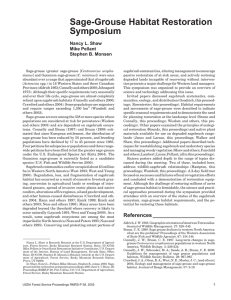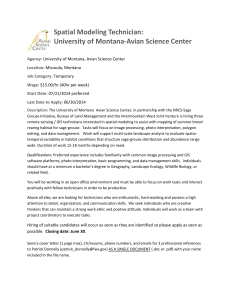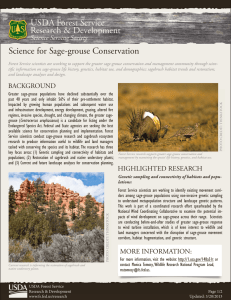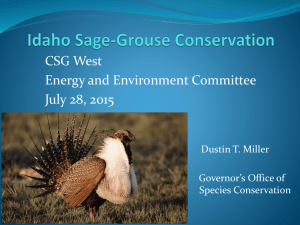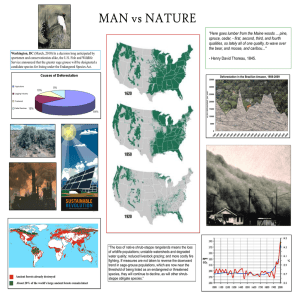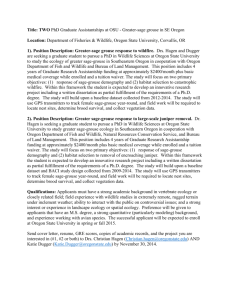Seasonal Habitat Requirements for Sage-Grouse: Spring, Summer, Fall, and Winter Introduction ____________________
advertisement
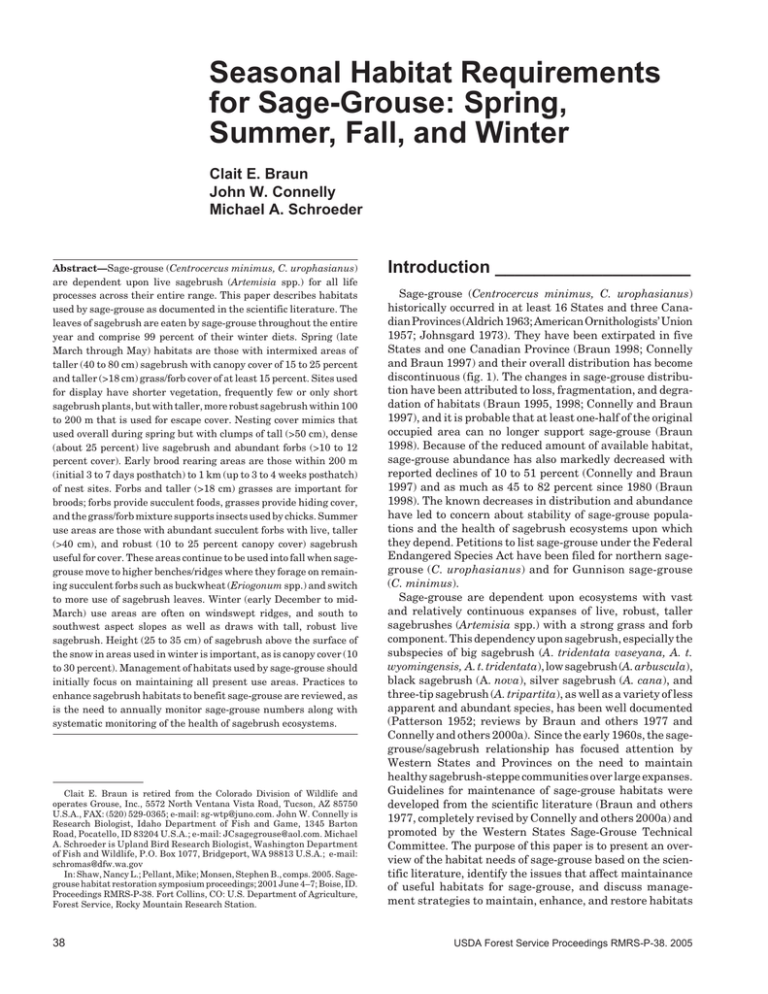
Seasonal Habitat Requirements for Sage-Grouse: Spring, Summer, Fall, and Winter Clait E. Braun John W. Connelly Michael A. Schroeder Abstract—Sage-grouse (Centrocercus minimus, C. urophasianus) are dependent upon live sagebrush (Artemisia spp.) for all life processes across their entire range. This paper describes habitats used by sage-grouse as documented in the scientific literature. The leaves of sagebrush are eaten by sage-grouse throughout the entire year and comprise 99 percent of their winter diets. Spring (late March through May) habitats are those with intermixed areas of taller (40 to 80 cm) sagebrush with canopy cover of 15 to 25 percent and taller (>18 cm) grass/forb cover of at least 15 percent. Sites used for display have shorter vegetation, frequently few or only short sagebrush plants, but with taller, more robust sagebrush within 100 to 200 m that is used for escape cover. Nesting cover mimics that used overall during spring but with clumps of tall (>50 cm), dense (about 25 percent) live sagebrush and abundant forbs (>10 to 12 percent cover). Early brood rearing areas are those within 200 m (initial 3 to 7 days posthatch) to 1 km (up to 3 to 4 weeks posthatch) of nest sites. Forbs and taller (>18 cm) grasses are important for broods; forbs provide succulent foods, grasses provide hiding cover, and the grass/forb mixture supports insects used by chicks. Summer use areas are those with abundant succulent forbs with live, taller (>40 cm), and robust (10 to 25 percent canopy cover) sagebrush useful for cover. These areas continue to be used into fall when sagegrouse move to higher benches/ridges where they forage on remaining succulent forbs such as buckwheat (Eriogonum spp.) and switch to more use of sagebrush leaves. Winter (early December to midMarch) use areas are often on windswept ridges, and south to southwest aspect slopes as well as draws with tall, robust live sagebrush. Height (25 to 35 cm) of sagebrush above the surface of the snow in areas used in winter is important, as is canopy cover (10 to 30 percent). Management of habitats used by sage-grouse should initially focus on maintaining all present use areas. Practices to enhance sagebrush habitats to benefit sage-grouse are reviewed, as is the need to annually monitor sage-grouse numbers along with systematic monitoring of the health of sagebrush ecosystems. Clait E. Braun is retired from the Colorado Division of Wildlife and operates Grouse, Inc., 5572 North Ventana Vista Road, Tucson, AZ 85750 U.S.A., FAX: (520) 529-0365; e-mail: sg-wtp@juno.com. John W. Connelly is Research Biologist, Idaho Department of Fish and Game, 1345 Barton Road, Pocatello, ID 83204 U.S.A.; e-mail: JCsagegrouse@aol.com. Michael A. Schroeder is Upland Bird Research Biologist, Washington Department of Fish and Wildlife, P.O. Box 1077, Bridgeport, WA 98813 U.S.A.; e-mail: schromas@dfw.wa.gov In: Shaw, Nancy L.; Pellant, Mike; Monsen, Stephen B., comps. 2005. Sagegrouse habitat restoration symposium proceedings; 2001 June 4–7; Boise, ID. Proceedings RMRS-P-38. Fort Collins, CO: U.S. Department of Agriculture, Forest Service, Rocky Mountain Research Station. 38 Introduction ____________________ Sage-grouse (Centrocercus minimus, C. urophasianus) historically occurred in at least 16 States and three Canadian Provinces (Aldrich 1963; American Ornithologists’ Union 1957; Johnsgard 1973). They have been extirpated in five States and one Canadian Province (Braun 1998; Connelly and Braun 1997) and their overall distribution has become discontinuous (fig. 1). The changes in sage-grouse distribution have been attributed to loss, fragmentation, and degradation of habitats (Braun 1995, 1998; Connelly and Braun 1997), and it is probable that at least one-half of the original occupied area can no longer support sage-grouse (Braun 1998). Because of the reduced amount of available habitat, sage-grouse abundance has also markedly decreased with reported declines of 10 to 51 percent (Connelly and Braun 1997) and as much as 45 to 82 percent since 1980 (Braun 1998). The known decreases in distribution and abundance have led to concern about stability of sage-grouse populations and the health of sagebrush ecosystems upon which they depend. Petitions to list sage-grouse under the Federal Endangered Species Act have been filed for northern sagegrouse (C. urophasianus) and for Gunnison sage-grouse (C. minimus). Sage-grouse are dependent upon ecosystems with vast and relatively continuous expanses of live, robust, taller sagebrushes (Artemisia spp.) with a strong grass and forb component. This dependency upon sagebrush, especially the subspecies of big sagebrush (A. tridentata vaseyana, A. t. wyomingensis, A. t. tridentata), low sagebrush (A. arbuscula), black sagebrush (A. nova), silver sagebrush (A. cana), and three-tip sagebrush (A. tripartita), as well as a variety of less apparent and abundant species, has been well documented (Patterson 1952; reviews by Braun and others 1977 and Connelly and others 2000a). Since the early 1960s, the sagegrouse/sagebrush relationship has focused attention by Western States and Provinces on the need to maintain healthy sagebrush-steppe communities over large expanses. Guidelines for maintenance of sage-grouse habitats were developed from the scientific literature (Braun and others 1977, completely revised by Connelly and others 2000a) and promoted by the Western States Sage-Grouse Technical Committee. The purpose of this paper is to present an overview of the habitat needs of sage-grouse based on the scientific literature, identify the issues that affect maintainance of useful habitats for sage-grouse, and discuss management strategies to maintain, enhance, and restore habitats USDA Forest Service Proceedings RMRS-P-38. 2005 Seasonal Habitat Requirements for Sage-Grouse: Spring, Summer, Fall, and Winter Braun, Connelly, and Schroeder British Columbia Alberta Saskatchewan Montana North Dakota Washington Idaho Oregon South Dakota Wyoming Nebraska Colorado Utah Historic Range Kansas Nevada Oklahoma California Current Range Arizona New Mexico Texas Figure 1—Historic and current distribution of sage-grouse (map prepared by M. A. Schroeder). for sage-grouse. This paper draws extensively on the published Guidelines to Manage Sage Grouse Populations and Their Habitats (Connelly and others 2000a). Habitat Overview ________________ Spring Timing of spring breeding activities of sage-grouse is dependent on elevation and amount of persistent snow cover. Attendance at leks may start in early to mid-March or, at higher elevations, in early April. Males may attend and display at leks until late May but most display and mating activities are greatly reduced by mid-May. Amount and depth of snow cover greatly influence sage-grouse breeding activities; thus, snow-free areas are important components of spring habitat. Habitats used by sage-grouse during the breeding period are those associated with foraging, leks, escape, and nesting. Depending upon moisture regimes, height of sagebrush in used habitats varies from 30 to 80 cm with canopy cover from 15 to 25 percent (Connelly and others 2000a). Lek sites typically have low amounts of sagebrush and appear relatively bare, but they may have extensive USDA Forest Service Proceedings RMRS-P-38. 2005 cover of low grasses and forbs. Taller, robust live sagebrush used as escape cover is normally within 100 to 200 m of active leks. The average distance from a nest to the nearest lek varies from 1.1 to 6.2 km, and the actual size of the breeding habitat appears largely dependent on the migratory characteristics of the sage-grouse population as well as distribution of sagebrush cover with respect to lek location (Connelly and others 2000a). Habitats selected for nesting are those with abundant (15 to 30 percent canopy cover) live, taller (30 to 80 cm) sagebrush plants within a community with >15 percent ground cover of taller (40 to 80 cm) grasses and forbs (Connelly and others 2000a). Early brood-rearing habitats (fig. 2) are normally those within 100 m to 1 km of nesting sites, especially areas with high plant species richness, moisture, and taller grasses and forbs (Connelly and others 2000a). Adult sage-grouse, while still foraging extensively on leaves of live sagebrush, eat leaves and flower parts of forbs during spring, as do chicks (Apa 1998; Drut and others 1994; Dunn and Braun 1986; Klott and Lindzey 1990). Summer Habitats used by sage-grouse in summer (early to midJune to mid to late September) are those that provide 39 Braun, Connelly, and Schroeder Seasonal Habitat Requirements for Sage-Grouse: Spring, Summer, Fall, and Winter into larger flocks frequently segregated by gender. Some birds may continue to use lower riparian or hayfield habitats, but there is movement onto higher, frequently northaspect slopes where succulent native forbs, such as buckwheats, provide green forage. Use of sagebrush leaves for food becomes more common as does use of extensive stands (>20 percent canopy cover) of taller (>25 cm), live sagebrush (Connelly and others 2000a). Movements can be slow but there is a general shift toward traditional winter use areas (Connelly and others 1988). Winter Fall (late September into early December) is a time of change for sage-grouse from being in groups of hens with chicks or males and unsuccessful brood hens to separation Flocks of sage-grouse are somewhat nomadic in early winter but may remain within chosen areas for periods of several weeks or more depending upon extent of snow cover and depth (Beck 1977; Hupp and Braun 1989b). Sagebrush height (>20 cm, but usually >30 cm, above the surface of the snow) is important as is the robust (>10 to 30 percent canopy cover) structure of live sagebrush (Connelly and others 2000a). Sage-grouse use a variety of sites in winter including windswept ridges with open (10 to 20 percent canopy cover) (fig. 4) stands of sagebrush to draws with dense (>25 percent canopy cover) stands. Quality of the snow can be important because sage-grouse are known to use snow roosts and burrows (Back and others 1987). Aspect is also important with south and southwest slopes most used in hilly terrain (Hupp and Braun 1989b). Leaves of live, vigorous sagebrush plants provide >99 percent of the foods eaten during the winter period (early December until early to mid-March) (Patterson 1952; Remington and Braun 1985; Wallestad and others 1975). Generally, winter is a time of body mass gain (Beck and Braun 1978), although severe winter conditions over prolonged intervals can reduce the amount of area available for foraging and cover (Beck 1977) and thus affect body condition (Hupp and Braun 1989a). Overall movement during winter may be extensive and home ranges can be large (Connelly and others 2000a). As winter wanes, flocks of sage-grouse move toward breeding areas that may be immediately adjacent to or far distant from winter use areas (Connelly and others 2000a). Figure 3—Radio-tracking sage-grouse in high-elevation summer range with a stand of mountain big sagebrush in the background (photograph by J. W. Connelly). Figure 4—Sage-grouse winter range in Wyoming big sagebrush habitat in North Park, Colorado (photograph by C. E. Braun). Figure 2—Sage-grouse brood hen in good quality Wyoming big sagebrush habitat, North Park, Colorado (photograph by C. E. Braun). adequate forage, especially succulent forbs, and cover useful for escape. These habitats may include those used for agriculture, especially for native and cultivated hay production, edges of bean and potato fields, as well as more typical sagebrush uplands and moist drainages. Taller (>40 cm) and robust (10 to 25 percent canopy cover) sagebrush is needed for loafing and escape cover as well as a source of food. Grass and forb ground cover can exceed 60 percent (hayfields). Provided moisture is available through water catchments or from succulent foliage, sage-grouse may be widely dispersed over a variety of habitats during this period (Connelly and others 2000a). As late summer approaches, there is movement from lower sites to benches and ridges (fig. 3) where sage-grouse forage extensively on leaves of sagebrush. Fall 40 USDA Forest Service Proceedings RMRS-P-38. 2005 Seasonal Habitat Requirements for Sage-Grouse: Spring, Summer, Fall, and Winter Issues _________________________ Decreases in distribution and abundance of sage-grouse have been ascribed to a complexity of factors (Braun 1987, 1998; Connelly and Braun 1997). The three major causes, (1) habitat loss (mostly permanent), (2) fragmentation (frequently permanent but reversible at times), and (3) degradation (usually can be corrected), are generally accepted but the latter two are poorly recognized and understood. Examples of permanent habitat loss include conversion of sagebrush rangelands to agricultural crops, town and subdivision developments, placement of power plants or surface mines, and reservoir construction. Fragmentation of habitats occurs with power lines, paved and other high-speed road development (including maintenance and improvement of farm roads), habitat-type conversion projects, fire, or any permanent development that reduces the size of existing habitat patches. Less understood are the impacts of fences, seasonal use trails, oil and gas wells with surface pipelines, noise, and so on. Some of these impacts can be resolved and sage-grouse will reoccupy some formerly disturbed areas (Braun 1987). Distribution of habitat types useful to sage-grouse is also important, as these species are habitat specialists using a variety of areas within a larger landscape mosaic. Thus, not only is the quantity of sagebrush habitats important, but also the juxtaposition and quality of those habitats. All sagebrush habitats are not equal in their acceptability to sage-grouse, and location of areas used may affect sagegrouse distribution. Size of habitat patches is important and 2 larger (>30 km ) is better than smaller, although the spatial relationships of habitats for sage-grouse are not well understood. Sage-grouse use a mosaic of habitats that is normally present in sagebrush-steppe because of differences in soils, moisture, topography, aspect, insect defoliation, wildfires, and other factors. Sagebrush naturally regenerates as overmature plants die and seedlings become established. Use of the term “decadent” for sagebrush is generally inappropriate because it implies that sagebrush communities are not dynamic with a variety of age classes from seedlings to overmature. Since most sagebrush communities are resilient and represent a continuum of age classes within a mosaic of habitats, creation of “edge” to benefit sage-grouse is rarely needed. Because of human activities, the presence of too much edge (especially in straight lines) is more common than too little edge and results in degradation of sage-grouse habitats. Sagebrush ecosystems have been managed through a variety of treatments from domestic livestock grazing, mechanical and chemical clearing or thinning, to use of prescribed fire (Braun 1998). Fire was a natural event in more mesic sagebrush communities but was infrequent as demonstrated by the lack of resprouting of big sagebrush, black sagebrush, and low sagebrush. Fire was more common in areas with three-tip sagebrush and silver sagebrush because both species resprout. Recent research suggests there is little gain in forage production of grasses and forbs after fire, because it can take longer than 30 years to return to preburn conditions (Wambolt and others 2001). Treatments of sagebrush communities have primarily been conducted to benefit another treatment (livestock grazing). Use of some treatments has led to plantings of exotic USDA Forest Service Proceedings RMRS-P-38. 2005 Braun, Connelly, and Schroeder grasses, invasion of areas by exotic plants, conifer invasion of sagebrush habitats, and increased fire frequency. Many, if not most, of these treatments have been applied to improve rangelands for domestic livestock but have had negative impacts on sagebrush communities and animals dependent on them (Braun and others 1976). Further, successive treatments have been applied to landscapes with little understanding of the cumulative effects that may impact both sagebrush-dependent animals, such as sage-grouse, and the overall health of the plant community. The impacts of natural events such as periodic drought are further exacerbated by human treatments of sagebrush communities. All of these issues emphasize the need for active protection of habitats presently used by sage-grouse as well as restoration of habitats that formerly supported sage-grouse populations. Sage-Grouse Habitat Management Strategies ______________________ The objectives of habitat management to benefit sagegrouse, in order of importance, should be (1) to protect and maintain existing occupied habitats, (2) enhance existing occupied habitats, (3) restore degraded habitats that still receive some sage-grouse use, and (4) rehabilitate significantly altered habitats that no longer support sage-grouse. Strategies to accomplish these objectives should include: • Vigorous suppression of wildfire. • Reconsideration of any use of prescribed fire. • Proper livestock management (including reconsideration of time of grazing, stocking rates, season of use, and frequency of use). • Use of nitrogen fertilizer, except in areas infested by annual weeds. • Mechanical chopping of sagebrush. • Fence type and placement. • Water management. • Rehabilitation and restoration techniques discussed in these proceedings. At times, manipulation of some occupied sage-grouse habitat may be necessary to enhance the overall quality of a seasonal range. An example would be removing or reducing some sagebrush canopy cover in known breeding habitat to enhance a depleted understory. Removal of 57 percent of sagebrush cover resulted in a significant decline in a sagegrouse breeding population (Connelly and others 2000b) and degradation of early brood-rearing habitat (Fischer and others 1996). More recently, a wildfire that removed about 30 percent of the sagebrush cover in a breeding habitat resulted in a 60 percent decline in sage-grouse nest success (Connelly, unpublished data, 1998). Because of this information and the fact that wildfires, drought, and insect infestations cannot be predicted, any sagebrush removal efforts should affect a relatively small portion of the occupied habitat. Connelly and others (2000a) suggested that >80 percent of breeding and winter habitat with vegetative characteristics necessary for productive sage-grouse habitat should remain intact to adequately provide for the needs of sage-grouse. However, an even greater percentage should be protected if sage-grouse populations are declining or the population status is unknown. All proposed habitat 41 Braun, Connelly, and Schroeder manipulations should carefully consider the current condition of habitat, status of the sage-grouse population, and likely outcome of the vegetation treatment, including recovery time necessary for the area to again provide adequate habitat for sage-grouse nesting and early brood rearing. Acknowledgments ______________ We thank S. B. Monsen for inviting our participation in the symposium that led to these proceedings. We further thank all managers and researchers who have contributed to the scientific literature and our understanding of sagegrouse and their use of habitats. Much of our knowledge was gained through research supported through Colorado (CEB), Idaho (JWC), and Washington (MAS) Federal Aid to Wildlife Restoration Projects. This is a contribution from the Western States/Provinces Sage and Columbian Sharp-Tailed Grouse Technical Committee. References _____________________ Aldrich, J. W. 1963. Geographic orientation of American Tetraonidae. Journal of Wildlife Management. 27: 529–545. American Ornithologists’ Union. 1957. Check-list of North Amerith can birds. 5 ed. Baltimore, MD: Lord Baltimore Press. 691 p. Apa, A. D. 1998. Habitat use and movements of sympatric sage and Columbian sharp-tailed grouse in southeastern Idaho. Moscow, ID: University of Idaho. 199 p. Dissertation. Back, G. N.; Barrington, M. R.; McAdoo, J. K. 1987. Sage grouse use of snowburrows in northeastern Nevada. Wilson Bulletin. 99: 488–490. Beck, T. D. I. 1977. Sage grouse flock characteristics and habitat selection in winter. Journal of Wildlife Management. 41: 18–26. Beck, T. D. I.; Braun, C. E. 1978. Weights of Colorado sage grouse. Condor. 80: 241–243. Braun, C. E. 1987. Current issues in sage grouse management. Proceedings of the Western Association of State Fish and Wildlife Agencies. 67: 134–144. Braun, C. E. 1995. Distribution and status of sage grouse in Colorado. Prairie Naturalist. 27: 1–9. Braun, C. E. 1998. Sage grouse declines in western North America: what are the problems? Proceedings of the Western Association of State Fish and Wildlife Agencies. 78: 139–156. Seasonal Habitat Requirements for Sage-Grouse: Spring, Summer, Fall, and Winter Braun, C. E.; Baker, M. F.; Eng, R. L.; Gashwiler, J. S.; Schroeder, M. H. 1976. Conservation Committee report on the effects of alteration of sagebrush communities on the associated avifauna. Wilson Bulletin. 88: 165–171. Braun, C. E.; Britt, T.; Wallestad, R. O. 1977. Guidelines for maintenance of sage grouse habitats. Wildlife Society Bulletin. 5: 99–106. Connelly, J. W. 1998. Unpublished data on file at: Idaho Department of Fish and Game, Pocatello, ID. Connelly, J. W.; Braun, C. E. 1997. Long-term changes in sage grouse Centrocercus urophasianus populations in western North America. Wildlife Biology. 3: 229–234. Connelly, J. W.; Browers, H. W.; Gates, R. J. 1988. Seasonal movements of sage grouse in southeastern Idaho. Journal of Wildlife Management. 52: 116–122. Connelly, J. W.; Reese, K. P.; Fischer, R. A.; Wakkinen, W. L. 2000b. Response of a sage grouse breeding population to fire in southeastern Idaho. Wildlife Society Bulletin. 28: 90–96. Connelly, J. W.; Schroeder, M. A.; Sands, A. R.; Braun C. E. 2000a. Guidelines to manage sage grouse populations and their habitats. Wildlife Society Bulletin. 28: 967–985. Drut, M. S.; Crawford, J. A.; Gregg, M. A. 1994. Brood habitat use by sage grouse in Oregon. Great Basin Naturalist. 54: 170–176. Dunn, P. O.; Braun, C. E. 1986. Summer habitat use by adult female and juvenile sage grouse. Journal of Wildlife Management. 50: 228–235. Fischer, R. A.; Reese, K. P.; Connelly, J. W. 1996. An investigation on fire effects within xeric sage grouse brood habitat. Journal of Range Management. 49: 194–198. Hupp, J. W.; Braun, C. E. 1989a. Endogenous reserves of adult male sage grouse during courtship. Condor. 91: 266–271. Hupp, J. W.; Braun, C. E. 1989b. Topographic distribution of sage grouse foraging in winter. Journal of Wildlife Management. 53: 823–829. Johnsgard, P. A. 1973. Grouse and quails of North America. Lincoln, NE: University of Nebraska Press. 553 p. Klott, J. H.; Lindzey, F. G. 1990. Brood habitats of sympatric sage and sharp-tailed grouse in Wyoming. Journal of Wildlife Management. 54: 84–88. Patterson, R. L. 1952. The sage grouse in Wyoming. Denver, CO: Sage Books, Inc. 341 p. Remington, T. E.; Braun, C. E. 1985. Sage grouse food selection in winter, North Park, Colorado. Journal of Wildlife Management. 49: 1055–1061. Wallestad, R. O.; Peterson, J. G.; Eng, R. L. 1975. Foods of adult sage grouse in central Montana. Journal of Wildlife Management. 39: 628–630. Wambolt, C. L.; Walhof, K. S.; Frisina, M. R. 2001. Recovery of big sagebrush communities after burning in south-western Montana. Journal of Environmental Management. 61: 243–252. Fernleaf biscuitroot 42 USDA Forest Service Proceedings RMRS-P-38. 2005
